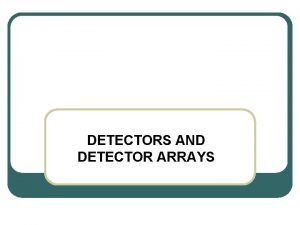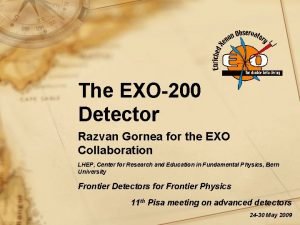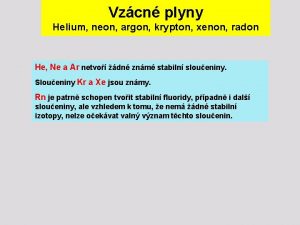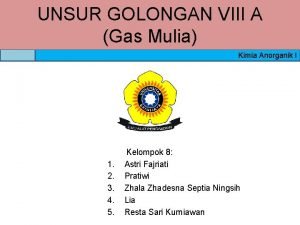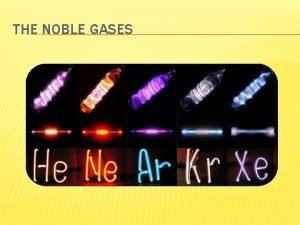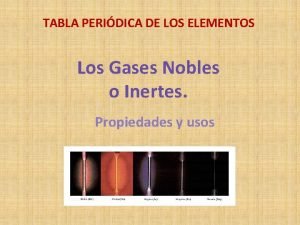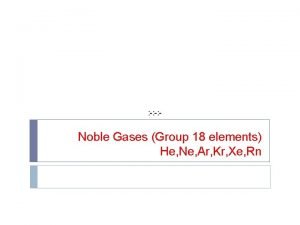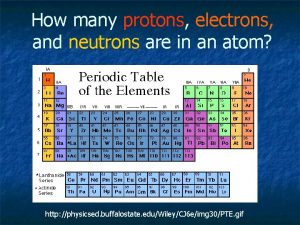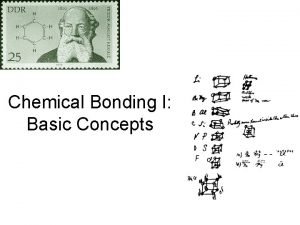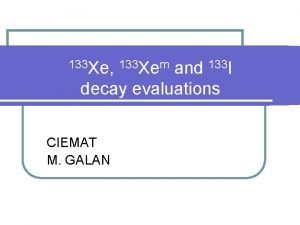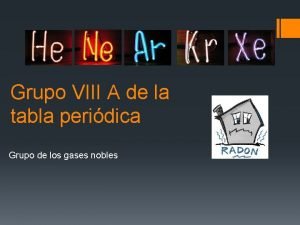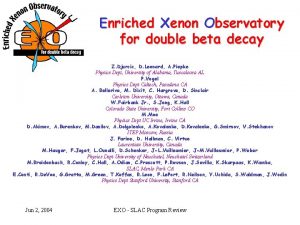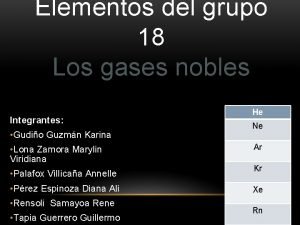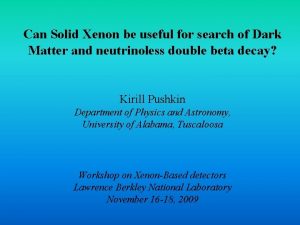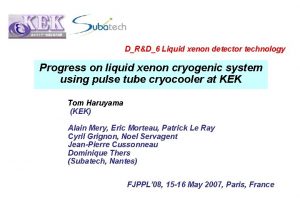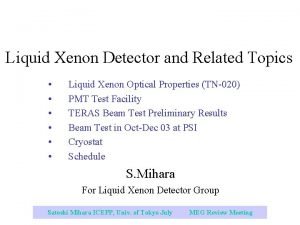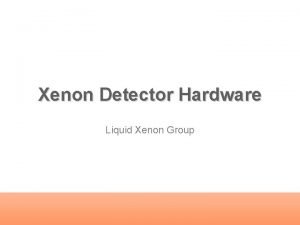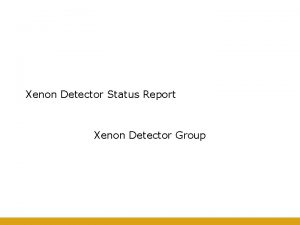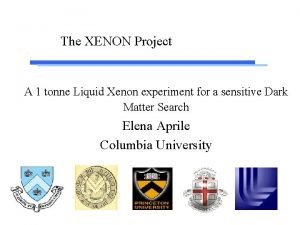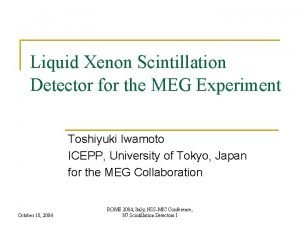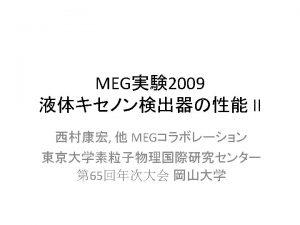DRD6 Liquid xenon detector technology 3 g Medical

















- Slides: 17

D_R&D_6 Liquid xenon detector technology 3 g Medical Imaging with liquid xenon and 44 Sc Eric Morteau, Patrick Le Ray, Cyril Grignon Noel Servagent, Jean-Pierre Cussonneau Dominique Thers (Nantes) Tom Haruyama (KEK) Wednesday, 09 May 2007 Workshop FJPPL’ 07, 9 -12 May 2007, KEK, Japan

1. 3 g Medical Imaging : concept and motivation 2. 44 Sc production at ARRONAX 3. Simulation and expected results with liquid xenon telescope 4. Liquid xenon technology 5. Expected schedule and Milestones

3 g Medical Imaging – never imagined before ? Not a “standard” imaging !

Positron Emission Tomography with + emitters + disintegration L Main incertitude on the emitter position : LOR length Human body Rat body L ~ 30 cm ~ 6 cm TOF-PET (260 ps) L ~ 9 cm LOR 2 D 5 mm 1 mm T. Doke et al. NIMA 569 (2006) Sub-centimetre precision along the LOR achievable ?

Single detection with a Compton telescope ray Known Event quantities: E 0 = Incident energy Measured Event quantities: E 0 E 1 = Energy lost by the scattered electron at the first hit x 1, y 1, z 1 = First Interaction Location x 2, y 2, z 2 = Second Interaction Location E 1, x 1, y 1, z 1 Derived Event quantities: E 0 and E 1 => scatter angle from Compton kinematics E 2, x 2, y 2, z 2 x 1, y 1, z 1 and x 2, y 2, , z 2=> cone axis Reconstructed direction: spatial resolution => axis of the cone energy resolution => opening angle LXe. GRIT: E. Aprile et al. NIMA 480 (2002)

… 3 imaging With a Compton telescope and a 3 emitter … 3 emitter L Reconstructed cone: axis , opening angle E 0 L related to Compton Telescope - positron range - LOR 2 D - Compton Telescope Which emitter ? Which Compton telescope ? 1 2 For which performances ?

A Compton telescope in association with a new radio-medicament + 94. 3 % E ~ 1 Me. V Only one Good for the Compton telescope No background Ultra fast emission Very precise time coincidence Mean + energy: 632 ke. V Maximum + energy: 1474 ke. V Other nuclides could be used, but 44 Sc is the most promising …

44 Sc, 44 m. Sc and 47 Sc productions at ARRONAX Accelerator for Research in Radiochemistry and Oncology in Nantes Atlantique Projectile Energy Me. V Intensity µA Proton 30 - 70 < 350 35 - fixed < 50 Deuteron 15 - 35 50 Alpha 70 - Fixed < 35 • 1 hall for high intensity • 1 experimental hall F. Haddad et al. , To be published, ND 2007 conf. September 2008: first beam 2009 : 44 Sc et 44 m. Sc production 2010 : 47 Sc production

Simulation for the proof of concept with small animal Present: Geant 4, Future: GATE (Subatech joined the collaboration in 2006) Liquid xenon Compton telescope 44 Sc point 8 8 individual cells (30 30 120 mm 3) source positron range, + acolinearity isotropic emission for 3 rd 120 mm Rat phantom (water): f= 60 mm Length = 150 mm Micro-PET (LSO crystals): Transverse FOV: = 260 mm Axial FOV = 76 mm 240 mm 148 mm + (Line Of Response) measured in a classical micro-PET 3 rd -ray measured in the Compton Telescope

44 Sc emitter Image Compton Telescope cone Micro-PET (LSO crystals) Rat phantom + LOR L ~ 2 mm XY slice Keys characteristics for the Compton telescope : Absolute sensibility on 3 th > 5% Angular resolution < 2° Maximum Flux per inch 2 ~ 104 s-1 Activity in the field of view ~ 1 MBq Liquid xenon is the good technology voxel: 2 2 2 mm 3

R&D on liquid Xenon Compton telescope

Liquid xenon technology : main physical properties Liquid xenon : Z = 54, r ~ 3 kg/l 95 % Compton Interaction @ 1 Me. V Energy deposited in liquid xenon : Both light and charge conversion Intrinsic scintillation due to dimer : 175 nm For @ 2 k. V/cm: Scintillation yield ~ 17000 UV/Me. V Ionization yield ~ 55000 e-/Me. V

Prototype for the proof of concept and for the R&D Cryocooler Internal cryostat Cathode Teflon PMT Liquid xenon External cryostat Entrance window Micromeshes and Anode Cryogenic and xenon distribution will be presented by Tom

Liquid Xenon Compton Telescope Principle 1 individual cell Cathode detection of scintillation light => trigger time t 0 PMT collection of e/i => t 1, E, x, y LXe UV 12 cm 2 1 Z Y TPC : z = (t 0 -t 1) x vdrift e- X 3 x 3 cm Micromegas (micromesh + 44 Sc -ray anode) 2 R&D for the TPC read-out …

R&D on UV detector G(Gaseous)PM : 1 inch PMT : Collaboration founded by French Ministry for Foreign Affairs 27 mm Developed by T. Doke et al. for liquid xenon TOF-PET R 5900 -06 AL 12 S-ASSY In test inside the prototype from June 2007 HPD : Gas-Avalanche Charge induction Amos Breskin et al. , NIM A 530(2004)258 Under discussion with PHOTONIS-DEP → Choice before end of 2008

R&D on ionization detector MICROMEGAS Y. Giomataris et al. NIMA 376 (1996) 511 ke. V Micromesh Spacer anode t 0 E 2 Conversion (AU) cathode t 0 t 1 Expected Induced current on anode without amplification 12 cm E 1 t 2 Ampli E 1 50 mm t 0 t 1 E 2 t 2 Induced current shape mostly independent of altitude → First tests in liquid xenon from June with unsegmented anode to check the liquid xenon purity Associated electronic and anode segmentation : Adaptation of the IDEFIX chip, a low noise charge preamplifier for Cd. Te device 200 e- noise on (¼ inch)2 pixel ? → Compton tracking in 2008

Schedule and Milestones Proof of concept Expected Achievement 1/ Conception and design 2/ Liquefaction commissioning (next Tom’s talk) 3/ First Signal and safety investigation 4/ Liquid xenon light and charge yield measurement 5/ Compton Tracking 6/ R&D for the TPC read-out 2006 April 2007 Small Animal Imaging July 2007 Oct. 2007 Feb. 2008 End 2008 Submission to FJPPL in 2008 ? 7/ Conception and design for the Small Animal 8/ Whole Body simulation with GATE 9/ Small Animal camera characterization 3 Imaging on Small Animal at the Ecole Nationale Vétérinaire de Nantes June 2008 End 2008 2009 First Image 2009/2010 Future 3 Imaging dedicated to the Whole-Body and the Public Health, research or industrialization ? Decision ~ 2010
 Xenon gas detector ct
Xenon gas detector ct Razvan gornea
Razvan gornea Commercial liquid dielectrics
Commercial liquid dielectrics Lever arm rule liquid-liquid extraction
Lever arm rule liquid-liquid extraction Argon xenon krypton
Argon xenon krypton Kegunaan gas kripton
Kegunaan gas kripton Xenon chemical properties
Xenon chemical properties Neon propiedades
Neon propiedades He, ne, ar
He, ne, ar Number of neutrons of xenon
Number of neutrons of xenon H2bf lewis structure
H2bf lewis structure Xenon 133 decay
Xenon 133 decay In an industrial process nitrogen is heated to 500k
In an industrial process nitrogen is heated to 500k Rd xenon
Rd xenon Grupo viii a de la tabla periodica
Grupo viii a de la tabla periodica Xenon decay
Xenon decay Elementos del grupo 18
Elementos del grupo 18 Solid xenon
Solid xenon
